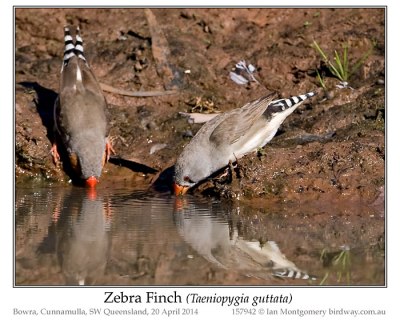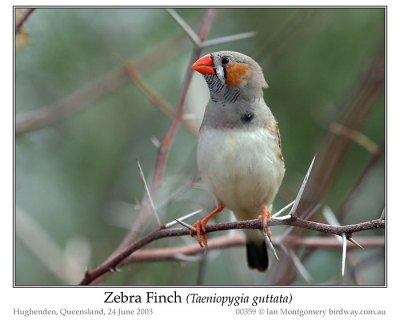
Ian’s Bird of the Week – Zebra Finch ~ by Ian Montgomery
Newsletter ~ 1/12/14
Here’s a perhaps surprising omission so far from the bird of the week series, the Zebra Finch, In Australia the most widespread of the grass- or weaver-finches (family Estrildidae). It is resident almost throughout mainland Australia, avoiding only the very driest deserts (such as the Nullabor Plain and the Great Sandy Desert), Cape York and the cooler and wetter regions of southern Victoria and southern Western Australia. It is absent from Tasmania. I qualified ‘surprising omission’ with ‘perhaps’, as it’s natural to rush into print with rarer and more sought-after species, such as Gouldian Finches, and overlook the more common ones.
With a length of 10cm/4in, it is among the smallest of the 19 species of Estrildid finches found in Australia (17 naturally; 2 introduced), but the males in particular (first photo) are beautiful birds and are hugely popular all over the world. Given the rigours of their natural habitat, they are hardy birds and easy to breed. One of my favourite ways to lazily photograph birds is to sit quietly near a waterhole in dry country and see what arrives, and you can see the bird in the first photo has wet breast and flank feathers from having a dip.

The second photo shows a pair drinking at the same spot. The male on the left is recognisable by its chestnut-coloured cheeks, while the female has plainer plumage, lacking the chestnut plumage on the cheeks and flanks and the stripes on the neck. She still has the stripy tail, white rump and diagnostic vertical ‘tear-drop’ stripe below the eye. This acts as camouflage by obscuring the eye and breaking up the outline of the head.
 The third photo shows another pair at the same place. They would appear to be having a difference of opinion about something, and the body language suggests to me that the female is getting the upper hand. Most females have plain breasts, but some have a faint breast band like this one. The fourth photo shows another pair, the female having the more typical plain plumage. These two look as if they’re not on very good terms either, definitely not speaking to each other, so you won’t be surprised to hear that Zebra Finches form permanent pair bonds.
The third photo shows another pair at the same place. They would appear to be having a difference of opinion about something, and the body language suggests to me that the female is getting the upper hand. Most females have plain breasts, but some have a faint breast band like this one. The fourth photo shows another pair, the female having the more typical plain plumage. These two look as if they’re not on very good terms either, definitely not speaking to each other, so you won’t be surprised to hear that Zebra Finches form permanent pair bonds.
 Their breeding cycles depend on seeding grasses and therefore on rainfall patterns. If the weather is warm enough for grasses to flower, the birds start breeding in response to rain, timing the hatching of the young with the appearance of seed. They will also feed on insects, particular when feeding young. In good conditions, the birds breed repeatedly, and the young, independent 35 days after hatching, can breed when as young as 80 days. Although the pair-bonds are permanent, Zebra Finches are very sociable, often breeding colonially and forming large flocks outside the breeding season. The bonding doesn’t prevent the females from getting on cosy terms with other males, and about 10% of clutches have two fathers (HBW).
Their breeding cycles depend on seeding grasses and therefore on rainfall patterns. If the weather is warm enough for grasses to flower, the birds start breeding in response to rain, timing the hatching of the young with the appearance of seed. They will also feed on insects, particular when feeding young. In good conditions, the birds breed repeatedly, and the young, independent 35 days after hatching, can breed when as young as 80 days. Although the pair-bonds are permanent, Zebra Finches are very sociable, often breeding colonially and forming large flocks outside the breeding season. The bonding doesn’t prevent the females from getting on cosy terms with other males, and about 10% of clutches have two fathers (HBW).

PAS-Estr Zebra Finch (Taeniopygia by Ian
Young juveniles resemble the females, but have dark bills. The bird in the fifth photo is an older juvenile male with still only patchy development of the adult plumage.
A closely related population is resident in the Lesser Sundas from Lombok to Timor. This is slightly larger, has a recognisable different song and the males have plain grey rather than striped throats and upper breast. When mixed with Australian birds on captivity, they normally avoid interbreeding unless the male plumage is painted to look like the other type or young birds have been imprinted by being reared by foster parents of the other type. Such hybrids are fertile. Even so, some authorities treat the two races as different species, the Timor and Australian Zebra Finches. ‘Zebra’ doesn’t seem to me a suitable name for the unstriped Timor one, maybe ‘Unzebra’ would be better?
Greetings
Ian
**************************************************
Ian Montgomery, Birdway Pty Ltd,
454 Forestry Road, Bluewater, Qld 4818
Tel 0411 602 737 ian@birdway.com.au
Bird Photos http://www.birdway.com.au/
Where to Find Birds in Northern Queensland: iTunes; Google Play Kobo Books
Recorder Society http://www.nqrs.org.au
Lee’s Addition:
Thanks again Ian for showing us some more beauties. I have seen these in captivity, but it is always nice to see them where they belong – out enjoying the great outdoors.
I also appreciate Ian telling us about how to distinguish between them. That third photo might be of the male being so “overwhelmed” by her beauty that he fell back and sat down to admire her. :0) (We really never know what a bird is thinking, do we?)
Looking at these birds can’t help but bring these verses to mind:
But he was wounded for our transgressions, he was bruised for our iniquities: the chastisement of our peace was upon him; and with his stripes we are healed. All we like sheep have gone astray; we have turned every one to his own way; and the LORD hath laid on him the iniquity of us all. (Isaiah 53:5-6 KJV)
Maybe the Lord created these birds with stripes to remind us of that fact.
The Zebra Finches are members of the Estrildidae Family which has 141 species. See:
Ian’s Estrididae Family
Estrildidae – Waxbills, Munias & Allies here
*


























